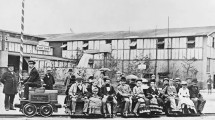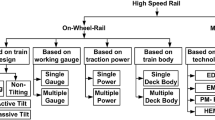Abstract
The rack force transmitted to a rack bar through a tie-rod is regarded as a major external force to the electric power steering (EPS) system. However, since road torque generated between the tire and the road surface is transmitted to the rack bar under the influence of road wheels and various linkages and bushings, it is difficult to equalize the rack force and road torque. This paper proposes a road torque modeling method and identifies the characteristics of EPS systems, including road torque. To estimate the road torque acting on the tire, an EPS system model including road wheels is proposed. The proposed EPS system model and the road torque model in the vehicle driving situations are validated with vehicle experiment results. The experimental results show that the proposed road torque model represents the characteristics of road torque in both stop and driving conditions, and the newly proposed EPS system model expresses the characteristics of the actual system better than the conventional EPS system model in the stop state.
Similar content being viewed by others
Abbreviations
- J 1 :
-
moment of inertia of the steering wheel, kg·m2
- J c :
-
moment of inertia of the steering column, kg·m2
- J m :
-
moment of inertia of the motor, kg·m2
- J fw :
-
moment of inertia of the road wheel, kg·m2
- M r :
-
mass of the rack bar, kg
- C 1 :
-
damping coefficient of the steering wheel, N·m/(rad/sec)
- C c :
-
damping coefficient of the steering column, Nm/(rad/sec)
- C m :
-
damping coefficient of the motor, Nm/(rad/sec)
- C fw :
-
damping coefficient of the steering linkage bushing, N·m/(rad/sec)
- C r :
-
damping coefficient of the rack bar, N·m/(rad/sec)
- K :
-
torsional stiffness of the torque sensor, N-m/rad KOB: torsional stiffness of the ball joint, N-m/rad
- N :
-
worm gear ratio
- N L :
-
steering knuckle arm, m
- θ 1 :
-
steering wheel angle, rad
- θ m :
-
motor angle, rad
- θ 2 :
-
steering column angle, rad
- θ fw :
-
road wheel angle, rad
- τ h :
-
driver torque, N·m
- τ a :
-
motor torque, N·m
- τ road :
-
road torque, N·m
- b r :
-
radius of rotation of the ball stud, m
- x r :
-
translational displacement of the rack bar, m
- r p :
-
radius of pinion, m
References
Badawy, A., Zuraski, J., Bolourchi, F. and Chandy, A. (1999). Modeling and analysis of an electric power steering system. SAE Paper No. 1999-01-0399.
Canudas-de-Wit, C., Tsiotras, P., Velenis, E., Basset, M. and Gissinger, G. (2003). Dynamic friction models for road/tire longitudinal interaction. Vehicle System Dynamics 50, 3, 189–226.
Chen, X., Yang, T., Chen, X. and Zhou, K. (2008). A generic model-based advanced control of electric power-assisted steering systems. IEEE Trans. Control Systems Technology 50, 3, 1289–1300.
Fahami, S. M. H., Zamzuri, H. and Mazlan, S. A. (2015). Development of estimation force feedback torque control algorithm for driver steering feel in vehicle steer by wire system: Hardware in the loop. Int. J. Vehicular Technology, 2015, 1–17.
Fankem, S. and Müller, S. (2014). A new model to compute the desired steering torque for steer-by-wire vehicles and driving simulators. Vehicle System Dynamics 52, sup1, 251–271.
Illán, J. T., Ciarla, V. and De Wit, C. C. (2011). Oscillation annealing and driver/tire load torque estimation in electric power steering systems. IEEE Int. Conf. Control Applications (CCA), Denver, Colorado, USA.
Kang, J. (2011). Theoretical model of ball joint squeak. J. Sound and Vibration 50, 3, 5490–5499.
Lee, D., Jang, B., Han, M. and Kim, S. (2021) A new controller design method for an electric power steering system based on a target steering torque feedback controller. Control Engineering Practice, 106, 104658.
Lee, D., Kim, K. S. and Kim, S. (2017). Controller design of an electric power steering system. IEEE Trans. Control Systems Technology 50, 3, 748–755.
Lee, D., Yi, K., Chang, S., Lee, B. and Jang, B. (2018) Robust steering-assist torque control of electric-power-assisted-steering systems for target steering wheel torque tracking. Mechatronics, 49, 157–167.
Ma, B., Yang, Y., Liu, Y., Ji, X. and Zheng, H. (2016). Analysis of vehicle static steering torque based on tire—road contact patch sliding model and variable transmission ratio. Advances in Mechanical Engineering 50, 3, 1–11.
Pang, D. Y., Jang, B. C. and Lee, S. C. (2005). Steering wheel torque control of electric power steering by PD-control. Int. Conf. Control, Automation, and Systems (ICCAS), Gyeonggi, Korea.
Song, J., Boo, K., Kim, H. S., Lee, J. and Hong, S. (2004). Model development and control methodology of a new electric power steering system. Proc. Institution of Mechanical Engineers, Part D: J. Automobile Engineering 50, 3, 967–975.
Sugitani, N., Fujuwara, Y., Uchida, K. and Fujita, M. (1997). Electric power steering with H-infinity control designed to obtain road information. American Control Conf. (ACQ), Albuquerque, New Mexico, USA.
Sugiyama, A., Kurishige, M., Hamada, H. and Kifiiku, T. (2006). An EPS control strategy to reduce steering vibration associated with disturbance from road wheels. SAE Paper No. 2006-01-1178.
Velenis, E., Tsiotras, P., Canudas-De-Wit, C. and Sorine, M. (2005). Dynamic tyre friction models for combined longitudinal and lateral vehicle motion. Vehicle System Dynamics 50, 3, 3–29.
Yasui, Y., Tanaka, W., Muragishi, Y., Ono, E., Momiyama, M., Katoh, H. and Imoto, Y. (2004). Estimation of lateral grip margin based on self-aligning torque for vehicle dynamics enhancement. SAE Trans., 632–637.
Acknowledgement
This research is supported by the Hyundai motor group.
Author information
Authors and Affiliations
Corresponding author
Additional information
Publisher’s Note
Springer Nature remains neutral with regard to jurisdictional claims in published maps and institutional affiliations.
Rights and permissions
About this article
Cite this article
Jang, B., Lee, D., Kim, K. et al. Road Torque Modeling for Electric Power Steering Systems. Int.J Automot. Technol. 23, 765–773 (2022). https://doi.org/10.1007/s12239-022-0068-0
Received:
Revised:
Accepted:
Published:
Issue Date:
DOI: https://doi.org/10.1007/s12239-022-0068-0




